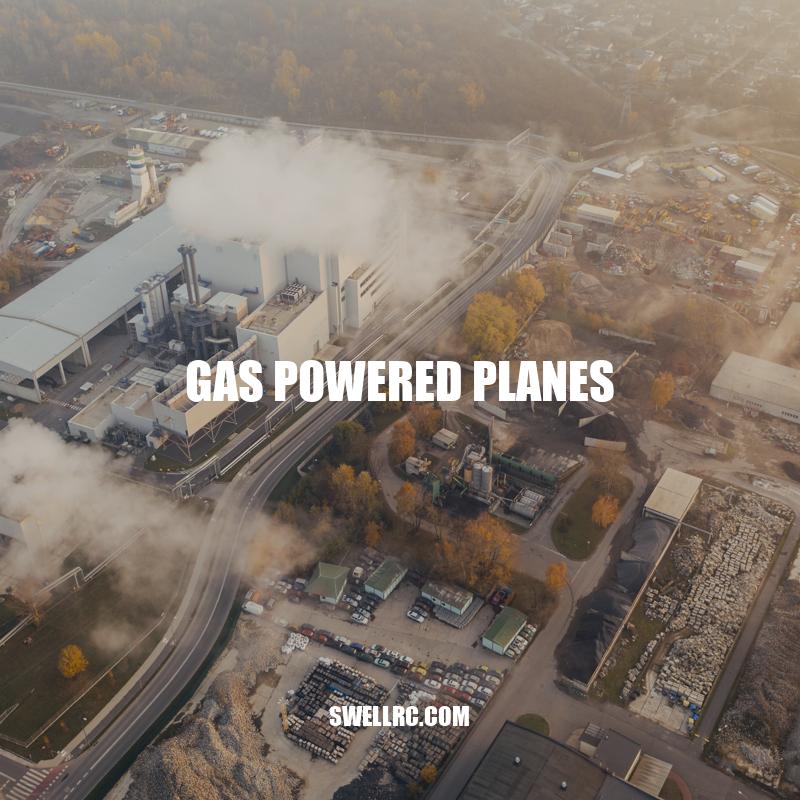Gas-Powered Planes: Efficiency, History, and Environmental Concerns.
Gas-powered planes have been a staple of aviation for over a century. These planes rely on internal combustion engines that are powered by gasoline or aviation fuel to propel the plane through the air. Gas-powered planes can range from small hobby models to large commercial aircraft, and offer pilots and aviation enthusiasts a powerful and reliable option for flying. The efficiency and power of these planes allows for high speeds, long distances, and heavy payloads, and also enables them to perform impressive aerobatic maneuvers and stunts. In addition to their performance capabilities, gas-powered planes are also appreciated for their responsiveness and control. However, there are also drawbacks to gas-powered planes, including their contribution to air pollution and climate change through emissions and their high fuel costs. Despite these concerns, gas-powered planes are likely to remain a popular choice for aviation enthusiasts for the foreseeable future, particularly for classic and historic planes that represent an important part of aviation history. However, it will be important for the aviation industry to continue to explore alternative fuel options that can reduce the environmental impact of flying while still providing a thrilling and rewarding experience for pilots and passengers alike.
Advantages of Gas-Powered Planes
Gas-powered planes offer a range of advantages for pilots and aviation enthusiasts:
- Powerful and efficient performance that allows for high speeds, long distances, and heavy payloads
- Ability to perform impressive aerobatic maneuvers and stunts
- Responsive and easy to control
- Availability of parts and equipment for maintenance and repairs
- Historical and nostalgic value for aviation enthusiasts
Despite concerns over emissions and fuel costs, these advantages have kept gas-powered planes a popular choice for many in the aviation industry. For those interested in purchasing or learning more about gas-powered planes, there are several websites and online communities dedicated to this niche interest. For example, the website GasPoweredModelAirplanes.com offers a variety of resources, including instructional articles and videos, product reviews, and community forums for enthusiasts to connect and share their experiences. Additionally, hobby and aviation stores often carry a variety of gas-powered plane models and equipment for sale, both in-store and online.
What were the advantages and disadvantages of the airplane?
Advantages and Disadvantages of the Airplane:
| Advantages | Disadvantages |
|---|---|
|
|
If you’re curious to learn more about aviation and airplanes, websites such as Aviation Today (https://www.aviationtoday.com/) or Aircraft Owners and Pilots Association (https://www.aopa.org/) offer in-depth articles, news and resources about this fascinating industry. You can also find aviation-related products and accessories on websites such as Aviation Supplies & Academics (https://www.asa2fly.com/) or Aircraft Spruce (https://www.aircraftspruce.com/).
Disadvantages of Gas-Powered Planes
While gas-powered planes offer many advantages, there are also several drawbacks to consider:
- Emissions that contribute to air pollution and climate change
- Noisier operation that can bother those living near airports or along flight paths
- Higher fuel costs compared to electric or alternative fuel options
- Increased maintenance needs due to the complexity of internal combustion engines
- Greater risk of fire for planes utilizing gasoline as fuel
Interestingly, one historic example of the drawbacks of gas-powered planes occurred during the Hindenburg disaster, where a zeppelin filled with hydrogen gas caught fire and crashed. This incident brought about greater interest in helium as a safer alternative gas for airships.
Despite the drawbacks, some pilots and aviation enthusiasts continue to prefer gas-powered planes for their power and performance. However, there are several alternative fuel options being developed to address the emissions and fuel cost issues, such as biofuels and hydrogen.
For those interested in learning more about alternate fuel options for aviation, the website of the U.S. Department of Energy offers a variety of resources and research on the topic, including the Alternative Fuels Data Center, which provides information about alternative fuels and infrastructure, as well as a model-specific database with fuel economy and emissions data.
Gas vs. Electric Planes: A Comparison
| Factor | Gas-Powered Planes | Electric Planes |
|---|---|---|
| Power and Efficiency | Powerful and efficient for long distances and heavy payloads | Less powerful and typically limited to shorter distances and lighter payloads |
| Noise | Noisier operation | Quieter operation |
| Emissions | Contributes to air pollution and climate change | Produces no direct emissions |
| Fuel Costs | Higher fuel costs compared to electric planes | Lower fuel costs compared to gas-powered planes |
| Maintenance | More complex and requires more maintenance | Simpler and requires less maintenance |
What are some disadvantages of airplanes?
Some disadvantages of airplanes are:
- High cost of tickets
- Possible delays and cancellations
- Potential health risks due to long flights and exposure to germs
- Contributing to air pollution and climate change
- No opportunity to make stops and explore places on the way to a destination
If you want to know more about the environmental impact of air travel, you can check out websites like Carbon Footprint or The International Council on Clean Transportation. Additionally, some travel products like carbon offsets or sustainable travel organizations aim to mitigate these negative effects.
The Future of Gas-Powered Planes
As alternative fuel options continue to be developed and air pollution and climate change become more pressing concerns, the future of gas-powered planes will likely change. Here are some potential developments to watch for:
- Greater adoption of alternative fuels such as biofuels and hydrogen, which could reduce emissions and fuel costs
- Improved efficiencies and lower costs for electric planes, which could make them a more attractive option for aviation enthusiasts
- Regulations limiting the use of gas-powered planes in certain areas to reduce noise and pollution
- Innovation in internal combustion engines, such as improved fuel efficiency and emissions control, to reduce the environmental impact of gas-powered planes
One company leading the way in developing alternative fuel options for aviation is Velocys, which is working on a process to convert municipal waste into biofuels for use in the aviation industry. Other companies are working on developing hydrogen fuel cells and electric planes with longer flight ranges.
For those interested in learning more about alternative fuel options for aviation, the website of the European Aviation Safety Agency provides a wealth of information on the topic, including research on alternative fuels, sustainable aviation fuels certification, and other sustainability initiatives in the aviation industry.
Advantages of Gas-Powered Planes vs. Other Modes of Transportation
| Factor | Gas-Powered Planes | Automobiles | Trains | Buses |
|---|---|---|---|---|
| Speed | Can travel long distances quickly | Slower and typically limited to shorter distances | Fast, but limited to travel along tracks | Slower and typically limited to shorter distances |
| Efficiency | Efficient for long distances and heavy payloads | Efficient for short distances and light payloads | Efficient for long distances, but requires dedicated infrastructure | Efficient for short to medium distances and large groups |
| Environmental Impact | Produces emissions that contribute to air pollution and climate change | Produces emissions that contribute to air pollution and climate change | Produces less emissions than cars or planes, but still significant | Produces emissions that contribute to air pollution and climate change |
| Noise | Noisy operation | Quieter operation | Noisy operation at high speeds | Noisy operation at high speeds |
What is the future of aircraft fuel?
The future of aircraft fuel is shifting towards sustainable and alternative options due to environmental concerns and the depletion of fossil fuels. Some alternative fuels currently being researched include biofuels made from waste materials, hydrogen fuel cells, and electric power. These options provide a cleaner and more renewable source of energy for aircraft. However, challenges still exist for the widespread adoption of these fuels such as cost, infrastructure, and availability. To stay informed about the latest developments in alternative aircraft fuels, check out websites such as Aviation Today or Green Car Congress.
Gas-powered planes are not just used for hobby or recreational purposes – they are also integral to the commercial aviation industry. Here are some things to know about gas-powered planes in commercial aviation:
- Major commercial airlines typically use jet fuel, which is a type of refined kerosene, to power their planes. However, these fuels are still hydrocarbon-based, and produce emissions that contribute to air pollution and climate change.
- Some smaller regional airlines still use gas-powered planes, particularly in areas where jet fuel infrastructure is lacking or cost-prohibitive. These planes are typically smaller and have shorter ranges than jet planes, but can still be an important part of regional transportation networks.
- Gas-powered planes are also used for many other commercial aviation purposes, such as cargo transport, aerial surveys, and even firefighting.
One interesting development in the use of gas-powered planes in commercial aviation is the use of biofuels. Some airlines, such as KLM and United, have experimented with using biofuels made from feedstocks such as cooking oil and agricultural waste. While the use of biofuels is still limited, it represents a potential avenue for reducing the environmental impact of commercial aviation.
For those interested in learning more about the use of biofuels in aviation, the website of the Sustainable Aviation Fuel Users Group provides information on the benefits of biofuels, as well as case studies of successful biofuel implementation in the aviation industry.
Do commercial airplanes use gasoline?
Commercial airplanes do not use gasoline, instead, they use a type of fuel called jet fuel or aviation turbine fuel (ATF). Jet fuel has a higher flash point and combustion temperature, making it suitable for high-altitude flight. Jet fuel is typically made from kerosene and is a type of highly refined diesel fuel. Additionally, there are various types of jet fuel, such as Jet A and Jet B, which have different specifications according to their specific use.
For further information, the International Air Transport Association (IATA) provides detailed information on jet fuels and their properties on their website.
Conclusion
Gas-powered planes have a long history in aviation and remain a popular option for aviation enthusiasts and commercial operators alike. While they offer power, efficiency, and a unique cultural appeal, they also have drawbacks related to emissions and fuel costs. As concerns about the environmental impact of aviation grow, it will be important for the industry to explore alternative fuel sources that can reduce emissions and minimize the industry’s carbon footprint.
However, the evolution of alternative fuel sources for aviation is still in its early stages, and gas-powered planes will remain an important part of aviation for the foreseeable future. The challenge will be to find ways to balance continued use of gas-powered planes with the urgency of addressing climate change. Whether through the continued development of biofuels, the adoption of electric or hybrid technology, or other innovations, the aviation industry will need to work hard to find sustainable solutions that allow us to continue flying while minimizing our impact on the planet.



